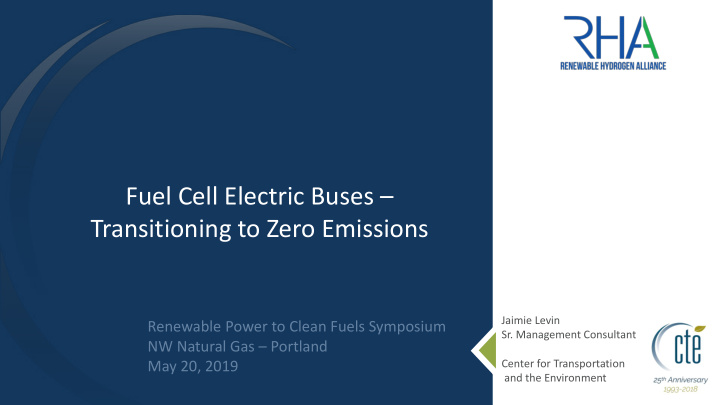



Fuel Cell Electric Buses – Transitioning to Zero Emissions Jaimie Levin Renewable Power to Clean Fuels Symposium Sr. Management Consultant NW Natural Gas – Portland Center for Transportation May 20, 2019 and the Environment
About CTE • Mission: To advance clean, sustainable, innovative transportation and energy technologies • 501(3)(c) non-profit engineering and planning firm • Portfolio - >$500 million – Research, demonstration, deployment – 86 Active Projects Totaling over $300 million • Focused on Zero-Emission Technologies • National Presence Atlanta, Berkeley, Los Angeles, St. Paul
47 CTE Members Leadership Circle Members Members
… Managing The Transition to ZEBs 4
Project Activity 5
Zero-Emission Projects ZEB Planning Projects ZEB Deployment Projects 6
Class 8 Fuel Cell Truck • Specifications – 85 kW Fuel Cell – 100 kWh Battery – 420 kW (560 HP) Motor – 30 kg Hydrogen Storage – Plug-in Capable • Performance – 80,000 lbs GVWR – 150-Mile Range – 65 mph Top Speed – Power: Maintains 30 MPH on 6% Grade – Torque: Enough to Start on 20% Grade – Port of Los Angeles – June 2018 https://www.todaystrucking.com/focus-kenworth-zero-emissions-cargo-transport/ 7
UPS Class 6 Fuel Cell Step-Van 15 2007 Trucks Retrofitted with Fuel Cells – 33 kW Fuel Cell – 49 kWh Battery – 9.8 kg Hydrogen Storage – 125-Mile Range U E S U N IQU E E L E C T R IC S OL U T ION S 4 New UPS Truck 8
Fuel Cell Top Loader Electric Top Loader with Wireless Charging and 90 kW Fuel Cell Range Extender Approximate Size and Weight of ETL Descriptor Weight/Measurement* Weight without Load 181,000 lbs. Front Axle Loading 230,000 lbs. with Load Overall Length 35 feet Overall Width Over 16 feet Drive Tires *Based on Hyster-Yale Diesel H1150HD-CH, 6-high Top Loader 9
H 2 Station Development • Largest Fuel Retailer in the World • Developing Light- and Heavy-Duty Fueling Stations • One 1,000 kg/day Truck Fueling Station with 100% Renewable Hydrogen (Port of Long Beach) • Two 1,000 kg/day Truck Fueling Stations Port of LA and Ontario Airport 10
ZEB Awards & Sales 11
U.S. Fuel Cell Electric Buses 12
Worldwide Acceptance 13
CARB Innovative Clean Transit Regulation • Full transition to zero-emission buses by 2040 • 2023, 25% of the total number of new bus purchases in each calendar year must be zero-emission buses • 2026, 50% of the total number of new bus purchases in each calendar year must be zero-emission buses • 2029, 100% new bus purchases must be zero- 10,524 Buses emission buses • Purchased new buses delivered within two years from the initial date of a Notice to Proceed • Rollout Plans by large transit agencies (100 or more buses) by July 1, 2020 14
CTE Fuel Cell Electric Bus Projects • AC Transit Expanded Service (13 Buses) • OCTA Demonstration (1 ElDorado Bus) • CUMTD Articulated Buses (2 Buses) • AC Transit ZEB Study/ZEB Corridor (BEB/FCEB) • San Diego ZEB Study (BEB/FCEB) • LA Metro ZEB Study • Spokane Transit and Shasta Regional Transportation ZEB Studies 15
FCEBCC and Next Steps • Fuel Cell Electric Bus Commercialization Consortium (FCEBCC) o $45 million o 20 Buses o Two Stations o Facility Upgrades • Next Step 100-Bus Initiative 16
ZEB OEMs 17
Operational Efficiency 18
FCEB Advantages 300 300 – 350 350 19
Durability: >32,000 Hours/2.8 Million Miles AC Transit FCEB Performance - May 14, 2019 FUEL CELL Bus Vehicle Miles Life to Date HOURS FC4 25,520 241,032 25,170 FC5 238,295 FC6 25,661 208,174 FC7 1 32,134 223,414 FC8 24,354 173,971 FC9 25,178 217,514 FC10 27,767 251,463 FC11 28,322 248,352 FC12 2 4,122 235,333 FC13 17,494 170,300 FC14 28,911 242,462 FC15 23,901 200,389 FC16 28,543 225,175 317,077 TOTALS 2,875,874 Average 26,388 221,221 NOTE: FC7 and FC12 fuel cells were manufactured by UTC in 2003, 14 years ago with an expected EOL of 5,000 hours. The other 11 fuel cells were manufactured by UTC in 2008 and 2009. * LDV Station converted to Messer commercial station as of September 2018. AC Transit stopped recording fuel dispensed as of May 2018. 1) Fuel Cell on FC7 retired on 5/14/18 with 32,134 hours. 2) Fuel Cell on FC12 retired 11/21/18 with 25,969 hrs. 20
New Flyer XHE40 Performance AC Transit 54 Line Service Total Projected Range Approximate Total Odometer Run Time Miles Miles Miles per Fuel Date Run Time Out Time In Based on 36 kg of Battery-Only Projected Run per kg DGE (1.13) Useable H2 Range Range (kg) * 4/10/19 54-0002 7:04 AM 10:42 PM 1697.4 300.9 20 320.9 4/11/19 54-0002 7:04 AM 10:42 PM 1896.3 15:46 hrs 198.9 23.8 8.36 9.44 324.6 20 344.6 4/12/19 54-2002 7:04 AM 10:42 PM 2098.3 15:46 hrs 202 22.4 9.02 10.19 344.8 20 364.8 4/13/19 54-2002 7:04 AM 10:42 PM 2298.5 15:46 hrs 200.2 20.9 9.58 10.82 Footnotes * Three different drivers. Variation in fuel consumption based on how different drivers drive and ambient temperature. Passenger Load (Seated capacity: 40 seats) AC Transit OCTA • Load = 17 Average; 34 Max • Seated Load (40) • 300 to 344 miles on H2 • 330 miles on H 2 • 20 miles on battery • 20 miles on battery 21
100-Bus Initiative 22
H 2 Infrastructure Challenges 23
The Challenge for 100% ZEB Deployment Infrastructure and Scalability Effort and Cost BEB FCEB Fleet Size 24
Fueling Station Evolution 12- to 15-Bus Capacity; Expand to 30 Buses 40’ x 60’ (50 -Bus Capacity) Parallel Fueling Underground LH2 Tanks and Pumps 25
International ZEB Conference in San Francisco September 26 an 27, 2019 WWW.ZEBConference.com Jaimie Levin Director of West Coast Operations Center for Transportation & the Environment (510) 851-0625 Jaimie@cte.tv
Recommend
More recommend